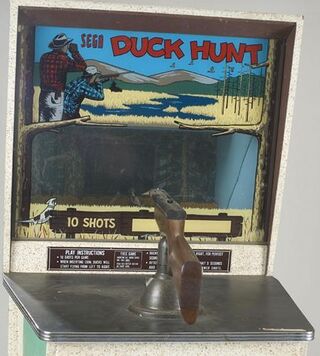Duck Hunt
From Sega Retro
| Duck Hunt | |||||
|---|---|---|---|---|---|
| System(s): Electro-mechanical | |||||
| Publisher: Sega | |||||
| Developer: Sega | |||||
| Genre: Shooter | |||||
| Number of players: 1 | |||||
|
Duck Hunt is a 1968 electro-mechanical arcade shooter game produced by Sega. A 25-cent video projection game, it features 10 animated ducks flying on a screen from left to right which disappear when shot with the attached shotgun controller.
The player receives ten shots, and the shot ducks are framed in a duck hunting score. Shooting the shot gun and hitting a duck produces a sound effect. The game dispenses a perforated computer card-style ticket showing shooting accuracy and score when game is finished which could be used for prizes or as a permanent record of the player's score. Additionally, the game could be set to give a free game for a perfect score.
Contents
Overview
It resembles a first-person light-gun shooter video game, but is in fact a video projection electro-mechanical (EM) game, using rear image projection in a manner similar to a zoetrope to produce moving animations on a screen.
This was the first electronic arcade game with animated targets displayed on a screen, in contrast to earlier EM arcade games that displayed actual physical static targets. This gave Duck Hunt the appearance of a video game, several years before the first true video games arrived in the arcades (Computer Space and Pong). Duck Hunt thus anticipated the kind of light-gun shooter video games that would later appear in the 1970s, and was the first electronic arcade game to display a first-person perspective on a screen. Duck Hunt was later updated by Midway and re-released in January 1973.
History
Background
In the late 1960s, Japanese companies Kasco (Kansei Seiki Seisakusho Co.) and Sega introduced a new type of electro-mechanical game, video projection games. They looked and played like later arcade video games, but relied on electro-mechanical components to produce sounds and images rather than a CRT display. They used rear video image projection to display moving animations on a video screen.[1][2][3] Video projection games became common in arcades of the 1970s. They combined electro-mechanical and video elements, laying the foundations for arcade video games, which adapted cabinet designs and gameplay mechanics from earlier video projection games.[3] They also ocassionally used solid-state electronics for sounds (like Grand Prix, Missile and Night Rider).
The first video projection games were Kasco's Indy 500, released in the late 1960s,[2] and Sega's Duck Hunt, released in 1968.[4][5][6]
Starting with Duck Hunt in 1968, Sega introduced video projection games. It used rear image projection in a manner similar to an ancient Chinese zoetrope to produce moving animations on a display screen. Duck Hunt was the first arcade game with animated moving targets displayed on a screen, in contrast to earlier EM arcade games that displayed actual physical static targets. This gave Duck Hunt the appearance of a video game, several years before the first true video games arrived in the arcades (such as Computer Space and Pong). Duck Hunt anticipated the kind of light-gun shooter video games that would later appear in the 1970s, and was the first arcade shooter to display a first-person perspective on a screen. It also printed out the player's score on a ticket, and had sound effects that were volume controllable.[5]
Legacy
After Duck Hunt, Sega produced several more electro-mechanical arcade games based on similar technology, using rear image projection to produce moving animations on a screen. In 1969, Sega released the EM games Grand Prix, a first-person driving/racing game like Kasco's Indy 500 that projects a forward-scrolling road on a screen, and Missile, a first-person vehicle combat simulation that had a moving film strip project targets on screen and a dual-control scheme where two directional buttons move the player tank and a two-way joystick with a fire button shoots and steers missiles onto oncoming planes, which explode when hit; in 1970, Missile was released in North America as S.A.M.I. Sega's Jet Rocket in 1970 was the earliest first-person shooter and combat flight simulator game, with cockpit controls that could move the player aircraft around a landscape displayed on screen and shoot missiles onto targets that explode when hit. In 1972, Sega released Killer Shark, a first-person light gun game known for appearing in the 1975 film Jaws.
The game also may have influenced Nintendo's light-gun shooters. In 1974, Nintendo's arcade light gun shooter Wild Gunman was a video projection EM game that used similar technology, but improved on it by using full-motion video projection to display live-action cowboy opponents on screen. In 1984, Nintendo released their own video game called Duck Hunt, which played similarly to Sega's 1969 electro-mechanical arcade game of the same name.
Specifications
- Height: 69"
- Width: 28"
- Depth: 38"
Gallery
Promotional material
- ↑ Killer Shark: The Undersea Horror Arcade Game from Jaws, D.S. Cohen, About.com
- ↑ 2.0 2.1 Kasco and the Electro-Mechanical Golden Age (Interview), Classic Videogame Station ODYSSEY, 2001
- ↑ 3.0 3.1 Once Upon a Time on the Screen: Wild West in Computer and Video Games, Academia
- ↑ https://books.google.com.bd/books?id=b0UEAAAAMBAJ&pg=PA33
- ↑ 5.0 5.1 1969 SEGA Duck Hunt (Arcade Flyer)
- ↑ Duck Hunt (1969)




